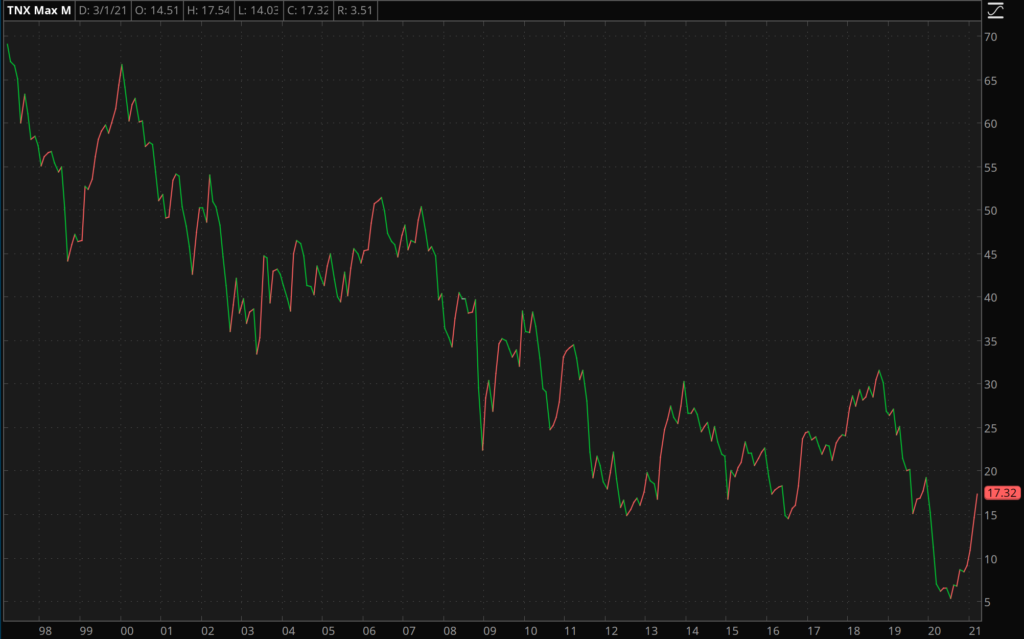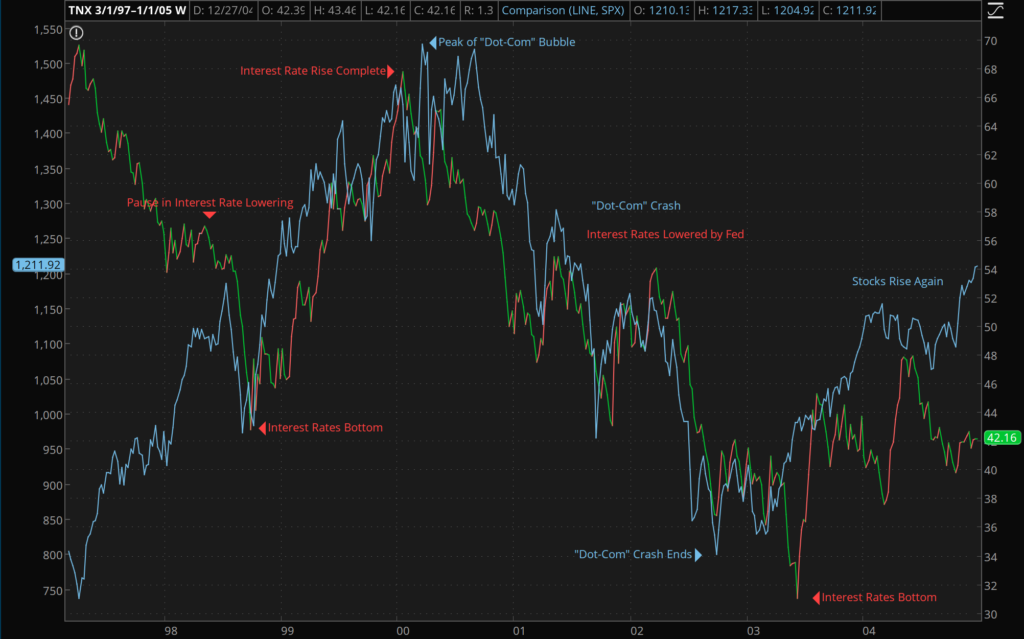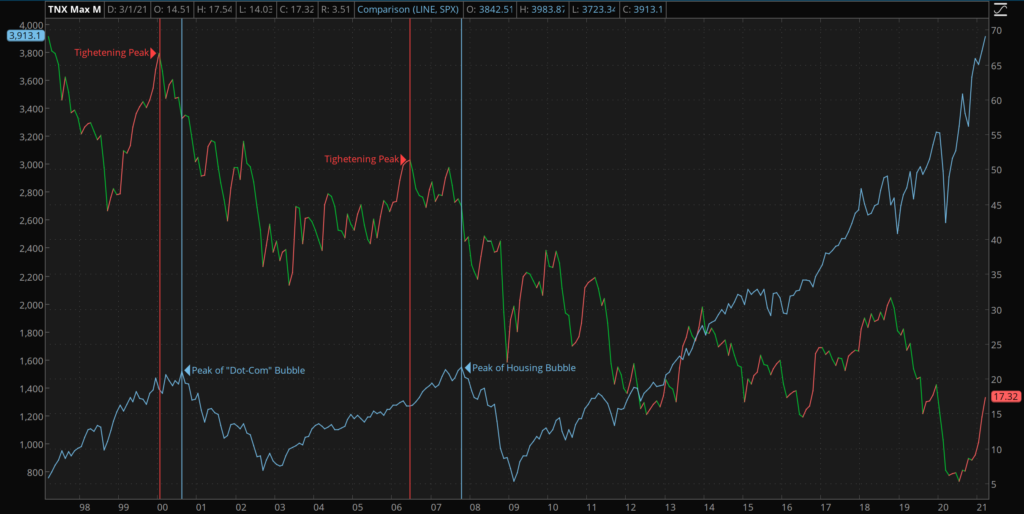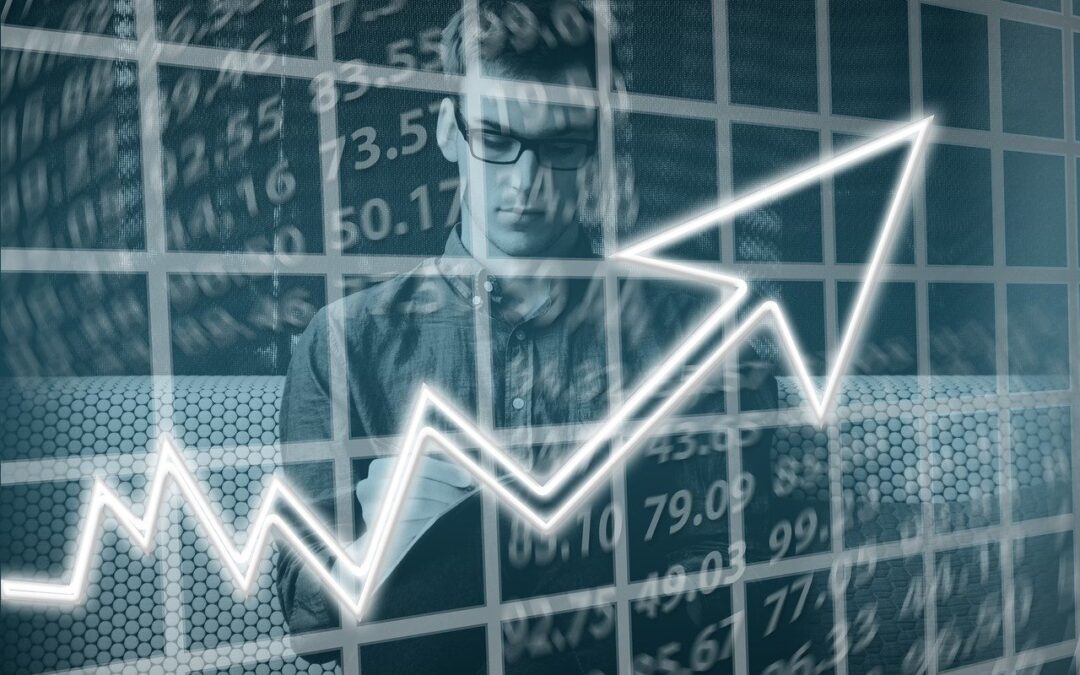Interest rates, or the price of borrowing money are a key element of any modern economy. I keep a weather eye on the ten year US treasury note yield.
Treasury yields don’t just influence how much the government pays to borrow and how much investors earn by buying government bonds. They also influence the interest rates that individuals and businesses pay to borrow money to buy real estate, vehicles, and equipment. Treasury yields also tell us how investors feel about the economy. The higher the yields on long-term U.S. Treasuries, the more confidence investors have in the economic outlook. But high long-term yields can also be a signal of rising inflation in the future.
https://www.investopedia.com/terms/t/treasury-yield.asp
As I write this the 10 year treasury yield is 1.73%. This is absurdly low from a historical perspective. For example, back in June of 2007 the 10 year yield was at 5.3%.
As you can see from the chart below, interest rates have been grinding steadily downwards for the past 20 plus years.

The 10 year yield bottomed out at 0.398% in March of 2020. Since then the 10 year yield has risen rather rapidly.
I think most people would agree inflation is at least about 2% per year. I don’t know what the real rate of price inflation is, but I suspect it is north of 2%. But for the sake of argument we’ll say dollars are worth 2% less each year.
So for the privilege of loaning the government money for 10 years, you’re going to get 1.73% in interest, even though the dollars will be worth 2% less. Now getting 1.73%, all else equal, is better than getting 0%. But it still doesn’t make sense that effective or real interest rates are negative, because while nominally you would be get more money back from the government, in real terms, you’d be getting paid back less. A normally functioning market isn’t supposed to work this way.
Interest is first supposed to compensate the lender for not having access to that money and two, to compensate them for the risk they are taking because the borrowing might not repay the loan and the lender might lose part or all of the money loaned.
In a free market, rising interest rates would be fine. It would just mean that lenders are demanding higher compensation in exchange for loaning their money.
Because US markets are unhealthily influenced (to use a polite term) rising interest rates pose several problems:
- In the aggregate most entities in the United States are heavily indebted, starting with individuals and families all the way to companies, State Governments and the Federal Government. Most States and the Federal government spend much more than they take in via taxes. The only way to make up the difference is to borrow the money by issuing debt. With interest rates rising, individuals, companies and governments have to pay more to borrow money. So these entities will either need to cut back on spending, or the amount of debt they accrue with increase.
- A lot of the elements of the US economy are accustomed to cheap money. There has been a large boom in housing demand due in part to people wanting to live in a nicer place since their ability to spend time outside the home has been very limited, combined with low interest rates that make it less expensive to borrow money to buy a house. The mortgage industry and real estate industry operate within the context of these low rates. If rates rise, that will put downward pressure on housing demand, and on the margin, people will not be able to service a mortgage at the higher interest rates.
- Stocks, particularly growth stocks in the technology sector have gone up a lot due to low interest rates. There are a variety of reasons for this. Low interest rates also mean it is inexpensive to borrow money to buy stocks with. Margin trading has also gone mainstream thanks to brokers like Robinhood. Higher interest rates means people can’t borrow as much money to buy stocks and all else equal this would put downward pressure on stock prices.
- With interest rates rising, bonds are more attractive. With rates effectively at zero nominally and zero or negative in real terms, people reach out along the risk curve. People who would be in government issued bonds might look to corporate bonds, which are considered riskier but pay a higher interest rate, those in corporate bonds might look to stocks, etc. With rising interest rates, if bonds do start paying a decent return (as judged by the investor) some folks on the margin will rotate money back into bonds.
I turn to CNBC to get a sense of what the mainstream, accepted narrative is. The narrative from folks over at CNBC is that the market is concerned about inflation, and so people are selling bonds to buy other assets and effectively demanding a higher rate of return in exchange for loaning the government money. There is also a theme that is repeated that rising rates are bad for the more speculative growth technology stocks.
What Impact Could Rising Rates have on Stocks?
I’m comparing certain periods of rising yields (using the 10-year to represent yields) and the ETF QQQ to represent stocks. QQQ is the 100 largest non-financial stocks in the NASDAQ. These are the stocks that CNBC wisdom would indicate would be most impacted by rising rates.
The big “dot-com” crash according to me, can be summarized thusly: the bubble was fueled by artificially low interest (courtesy of Allan Greenspan’s Federal Reserve), “investors” used cheap money to speculate on internet technology stocks with little or no earnings. When the Fed then tried to raise rates, the low interest rate “air” that was blowing the bubble was limited, causing the bubble to pop and stocks to crash.
The chart below shows the “QQQs” rising as interest rates fell. The Fed stopped cutting rates in September of 1998. The QQQs continued to rise, even as interest rates rose. But then technology stocks peaked in March of 2000 and then proceeded to crash 43% from this peak, until bottoming out in September of 2002. In order to get the “Dot-Com” crash to stop, the Fed had to lower interest rates even further.

Fast forward, the Fed then tried raising rates again, albeit very slowly, and in 2007-2008 the housing market crashed and the Fed had to cut rates.
There hadn’t been a major crash since 2008, up until the March 2019 government lockdowns shut down much of the economy throughout the world. The yield on the 10 year note has not gotten back above 4.174% since the housing bubble popped.

The lowest rates have gotten since March of 1997 is 0.398%, which happened in March of 2020. Rates have since risen to their current level of 1.732%. As the talking heads will point out, these are still historically low rates. That is true.
But amount of debt in the system has never been this high. In 2000 when the 10 year note yielded 6.5% the US had a debt to GDP ratio of 58.7% and the national debt was “just” $5.7 trillion. US National debt is now over $28 trillion and the debt to GDP is now over 129%.
Can the US afford to pay 6.5% on 10 year debt?
The other factor is the pace at which rates have risen. In one year the 10-year note yield has gone from a low of 0.398% to 1.732%, that is a 335% increase in 365 days.
In the lead up to the dot com crash, the 10 year yield went from 4.4% in September of 1998 up to 6.82% in August of 2000. That is a 55% increase over 700 days.
In the lead up to the housing bubble crash, the 10 year went from 3.29% in May of 2003 to 5.25% in June of 2006. That is a 59% increase over 1127 days.
Does rapid pace of this relative increase matter?
If the past is any indication the impact isn’t going to be immediate. In the past two major financial crashes, interest rates were already dropping again before the peak in the QQQs. Rates peaked in January of 2000 but stocks didn’t start selling off until August of 2000. In the housing bubble, rates peaked June of 2006 and the QQQs didn’t start selling off until October of 2007. You can see the delay visually in the chart below.

I certainly don’t know if rising rates will cause a stock market correction. Perhaps this time is different. If I could time the markets I would be much richer than I am. But rising rates are something to keep an eye on and in the past they have preceded stock market selloffs.
It does seem likely that the Federal Reserve will never be able to normalize interest rates. There have been periods of rising rates, but the clear trend is downward. The 10-year came close to zero in July of 2020. In the next crisis, rates will probably have to go negative.
Will anyone besides the US Federal Reserve want to loan the US Government money for 10 years at a negative nominal rate (and who knows how negative real rate)?

